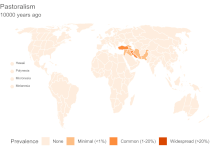
Pastoralism
Branch of agriculture concerned with raising livestock / From Wikipedia, the free encyclopedia
Dear Wikiwand AI, let's keep it short by simply answering these key questions:
Can you list the top facts and stats about Pastoralism?
Summarize this article for a 10 years old
Pastoralism is a form of animal husbandry where domesticated animals (known as "livestock") are released onto large vegetated outdoor lands (pastures) for grazing, historically by nomadic people who moved around with their herds.[2] The animal species involved include cattle, camels, goats, yaks, llamas, reindeer, horses, and sheep.[3]
| Part of a series on |
| Economic, applied, and development anthropology |
|---|
|
Provisioning systems |
|
Case studies
|
| Social and cultural anthropology |
.jpg/220px-Nomadic_Camping_(266139768).jpg)

Pastoralism occurs in many variations throughout the world, generally where environmental characteristics such as aridity, poor soils, cold or hot temperatures, and lack of water make crop-growing difficult or impossible. Operating in more extreme environments with more marginal lands means that pastoral communities are very vulnerable to the effects of global warming.[4]
Pastoralism remains a way of life in many geographic areas, including Africa, the Tibetan plateau, the Eurasian steppes, the Andes, Patagonia, the Pampas, Australia and many other places. As of 2019[update], between 200 million and 500 million people globally practiced pastoralism, and 75% of all countries had pastoral communities.[4]
Pastoral communities have different levels of mobility. Sedentary pastoralism has become more common as the hardening of political borders, land tenures, expansion of crop farming, and construction of fences and dedicated agricultural buildings all reduce the ability to move livestock around freely, leading to the rise of pastoral farming on established grazing-zones (sometimes called "ranches"). Sedentary pastoralists may also raise crops and livestock together in the form of mixed farming, for the purpose of diversifying productivity, obtaining manure for organic farming, and improving pasture conditions for their livestock. Mobile pastoralism includes moving herds locally across short distances in search of fresh forage and water (something that can occur daily or even within a few hours); as well as transhumance, where herders routinely move animals between different seasonal pastures across regions; and nomadism, where nomadic pastoralists and their families move with the animals in search for any available grazing-grounds – without much long-term planning. Grazing in woodlands and forests may be referred to as silvopastoralism.[5] Those who practice pastoralism are called "pastoralists".
Pastoralist herds interact with their environment, and mediate human relations with the environment as a way[citation needed] of turning uncultivated plants (like wild grass) into food. In many places, grazing herds on savannas and in woodlands can help maintain the biodiversity of such landscapes and prevent them from evolving into dense shrublands or forests. Grazing and browsing at the appropriate levels often can increase biodiversity in Mediterranean climate regions.[6][7] Pastoralists shape ecosystems in different ways: some communities use fire to make ecosystems more suitable for grazing and browsing animals.